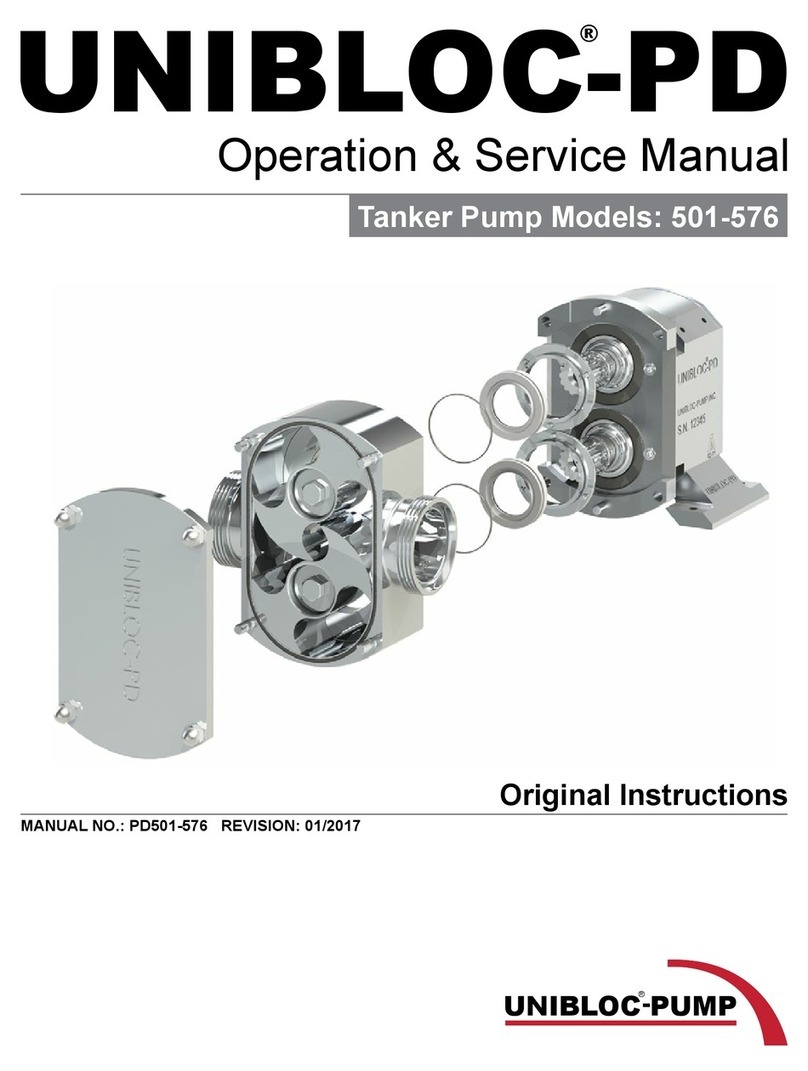
UNIBLOC-PD Operation & Service Manual: PD200-576 3
Contents
1.0 General ................................................................................................................5
1.1 Declaration of Conformity.................................................................................................. 5
1.2 General Description............................................................................................................ 7
1.2.1 Limitation .................................................................................................................................................. 8
1.2.2 Noise Emission ........................................................................................................................................ 8
1.2.3 Marking – CE ............................................................................................................................................ 8
1.2.4 Marking – Standard.................................................................................................................................. 8
2.0 Safety...................................................................................................................9
2.1 General ................................................................................................................................ 9
2.2 Safety Instructions ............................................................................................................. 9
3.0 Installation.........................................................................................................11
3.1 Handling and Storage....................................................................................................... 11
3.2 System Design .................................................................................................................. 12
3.3 Flushed Seal Arrangement .............................................................................................. 12
3.3.1 Single and Double Mechanical Seal Flushing/Cooling ...................................................................... 12
3.3.2 Double O-Ring Seal Flushing/Cooling ................................................................................................. 14
3.4 Pre-Start Check List ......................................................................................................... 14
4.0 Maintenance......................................................................................................15
4.1 Clean In Place, CIP ........................................................................................................... 15
4.2 Steam In Place, SIP........................................................................................................... 15
4.3 Maintenance Schedule and Recommended Spare Parts.............................................. 16
4.4 Shaft Seal Service............................................................................................................. 16
4.4.1 Single Mechanical Seal.......................................................................................................................... 17
4.4.1.1 UNIBLOC-PD 200-275 Single Mechanical Seal Removal........................................................................... 17
4.4.1.2 UNIBLOC-PD 200-275 Single Mechanical Seal Installation....................................................................... 17
4.4.1.3 UNIBLOC 300-575 Single Mechanical Seal Removal ................................................................................. 18
4.4.1.4 UNIBLOC 300-575 Single Mechanical Seal Installation ............................................................................. 18
4.4.1.5 UNIBLOC 501, 551, 576 Front Loaded Single Mechanical Seal Removal ................................................ 19
4.4.1.6 UNIBLOC 501, 551, 576 Front Loaded Single Mechanical Seal Installation ............................................ 19
4.4.2 Flushed Single Mechanical Seal........................................................................................................... 20
4.4.2.1 Flushed Single Mechanical Seal Removal.................................................................................................. 20
4.4.2.2 Flushed Single Mechanical Seal Installation.............................................................................................. 20
4.4.3 Double Mechanical Seal ....................................................................................................................... 21
4.4.3.1 Double Mechanical Seal Removal ............................................................................................................... 21
4.4.3.2 Double Mechanical Seal Installation ........................................................................................................... 22
4.4.4 Double O-Lip™ Seal............................................................................................................................... 23
4.4.4.1 UNIBLOC 200-575 Double O-Lip™ Seal Removal ..................................................................................... 23
4.4.4.2 UNIBLOC 200-575 Double O-Lip™ Seal Installation .................................................................................. 23
4.4.4.3 UNIBLOC 501, 551, 576 Front Loaded Double O-Lip™ Seal Removal ..................................................... 24
4.4.4.4 UNIBLOC 501, 551, 576 Front Loaded Double O-Lip™ Seal Installation ................................................. 24
4.4.5 Single O-Ring Seal ................................................................................................................................. 25
4.4.5.1 UNIBLOC 200-275 Single O-Ring Seal Removal......................................................................................... 25
4.4.5.2 UNIBLOC 200-275 Single O-Ring Seal Installation..................................................................................... 25
4.4.5.3 UNIBLOC 300-575 Single O-Ring Seal Removal......................................................................................... 26
4.4.5.4 UNIBLOC 300-575 Single O-Ring Seal Installation..................................................................................... 26
4.4.6 Double O-Ring Seal................................................................................................................................ 27
4.4.6.1 Double O-Ring Seal Removal....................................................................................................................... 27
4.4.6.1 Double O-Ring Seal Installation................................................................................................................... 27
4.4.7 UNIBLOC 200-575 Seal Installation – Final Step ................................................................................ 28
4.4.8 UNIBLOC 501 Series Seal Installation – Final Step ............................................................................ 29





























